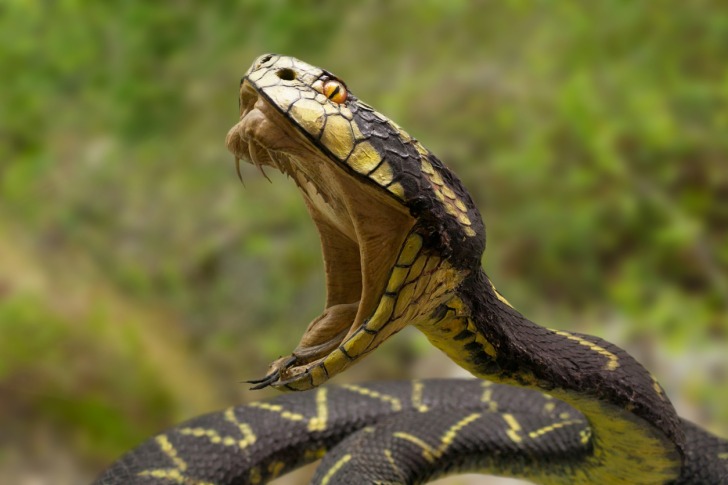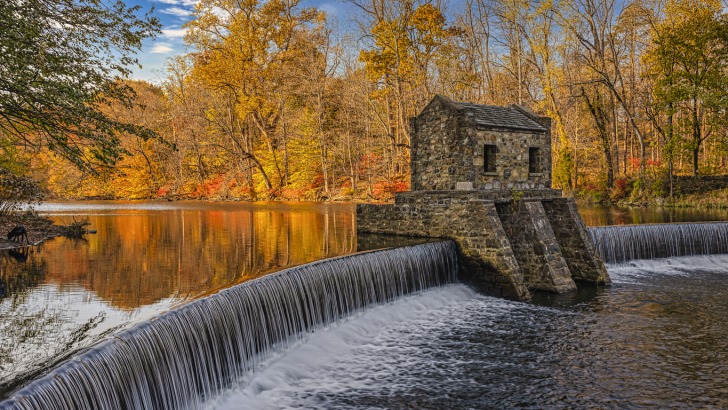Snakes, scientifically known as Serpentes, induce a primal reaction in most animals.
These elongated, limbless reptiles are everywhere, but because they are ectothermic – cold-blooded, they prefer warmer climes.
Snakes can be found on every continent but Antarctica!
Not all squamates are poisonous, but all are carnivorous.
Snakes tend to avoid people choosing small animals or even other snakes as primary prey.
There are over 3,400 snake species worldwide, and none of them are herbivores.
A snake sighting in New Jersey is highly likely, but which reptile is dependent on what part of the state you visit.
Rocky hills and coastal areas are home to benign milk snakes.
Meanwhile, water snakes love small bodies of water.
Overall, the snakes in New Jersey are passive.
But a few species mimic the colors and patterns of the poisonous brethren.
So, just to stay safe, always respect a snake’s territory.

Contents
So… Are There Snakes in New Jersey?
New Jersey, the fifth-smallest state in the country, is east of Philadelphia on the eastern Atlantic coast.
The state’s varied geography provides a range of snake habitats.
New Jersey is home to 20 non-venomous species, and two are considered deadly.
Snake Species in New Jersey
New Jersey is snake central for the tri-state area, with 22 species.
They are divided by geographic region: north, south, east, and west New Jersey.
And they come in all shapes, patterns, and sizes – many are common, and a few are endangered.
Luckily, however, only a couple of the Garden State’s reptilian residents are venomous.
Northern Water
The northern water snake is considered the most common reptile.
It prefers freshwater streams, ponds, and bogs.
It grows to between two and four feet and is brown or gray with red or black bands around its neck.
These markings mimic the Northern Copperhead, which keeps its predators at bay.
If startled, the snake will inflict a painful but non-venomous bite.
Eastern Milk
Milk snakes are a New Jersey mainstay.
Their habitat ranges from fields and woods to riverbanks.
Milk snakes grow to between two and 4.5 feet and are exceptionally fond of rodents.
The reptile’s gray and red or brown blotches are outlined in black and resemble the venomous northern copperhead and timber snake.
They are egg layers with a distinct Y- or V-shaped light patch on their neck.
Coastal Plain Milk
Further south, the eastern milk snake breeds with the Scarlet snake, producing the rare “coastal plain milk snake.”
The hybrid’s habits and tendencies are similar to the eastern milk snake, but its coloring mimics the Timberlake rattler.
Corn Snake
The corn snake is found in the Pine Barrens.
The locals call it a “red rat” snake.
It grows from two to six feet long and inhabits sandy, forested areas with piney underbrush.
Because of its affinity for pine trees, hollow logs, and railroad ties are likely habitats.
Corn snakes vary in color from gray to orange-brown, with black-outlined blotches or stripes.
They are egg layers and will strike when disturbed, but non-venomous.
The corn snake is an endangered species.
Rough and Smooth Green Snakes
New Jersey is also home to benign green snakes.
Mostly known as ‘grass snakes,’ they grow to two feet, are non-venomous, and are common throughout New Jersey and the mid-west.
Eastern Garter Snake
A slender snake, the Eastern Gartner is the most common snake in the Garden State and is indigenous to North America.
It is considered medium-sized, growing to between 1.5 and 2 feet long.
They are brown or black with yellow or white stripes down the length of the body.
They can be found in grassy fields, trash dumps, and stony walls or outcrops.
Garter snakes are not poisonous but will strike and spray a foul secretion if threatened.
King Snake
Exclusive to south New Jersey, the common snake grows between four and seven feet long.
It likes the in-between areas of swamps and logs.
They are locally known as the “chain snake,” the black and brown body with milky links resembling a chain.
Their diet includes timber rattlesnakes and rodents.
Queen Snake
Not to be outdone by the ‘King Snake,’ New Jersey also has a Queen Snake.
Similar in appearance to a garter snake, the Queen is often black with yellow and white stripes down its body.
It is particular where it lives, requiring clean streams with a minimal temperature of 50° F.
Non-venomous, its diet is almost exclusively crayfish.
Northern Copperhead
New Jersey’s Northern Copperheads are found exclusively near Piedmont and the Highlands.
These pit vipers become active in early spring and are known for heat-sensing organs.
Picky eaters, northern copperheads prefer small animals such as mice.
Deadly, they are also considered passive because they rarely strike unless provoked.
Their venom is poisonous to smaller animals, but no New Jersey deaths have been recorded.
Timberlake Rattlesnake
The pit viper is also known as the canebrake.
Indigenous to eastern Northern America, it is one of 26 subspecies evenly distributed east of the Mississippi River.
They are yellowish-brown, gray, or black with cross-bands in an irregular zigzag pattern.
Timberlake’s also have a tell-tale and terrifying rattle.
They prefer small animals and garter snakes – perching on logs or adopting a vertical stance by leaning against a tree, to wait for prey.
The long fangs, impressive size – two to five feet long, and concentrated venom make these snakes dangerous.
But they also give a fair warning – rattling and posturing before they eventually strike.

Is it Safe to Go on a Trek in New Jersey?
New Jersey is filled with trails, forests, and rocky beaches – perfect for exploring.
Snakes in the Garden State are more active during the spring, summer, and early fall.
As with all outdoor activities, proper preparation and knowledge of one’s surroundings are key to staying safe.
Interesting Snake Facts in New Jersey
One of the Garden State’s reptilian residents is currently endangered.
The corn snake (Pantherophis Guttatus) is losing its habitat due to the development of forest and field land.
They are also being hunted as pets.
3 Safety Tips for Exploring Nature in New Jersey
- Keep your distance! Most snakes have a laissez-faire attitude and will usually leave you alone. But if startled or touched, or if they are defending their nest, they will strike.
- Beware rocks and logs: Be aware of your surroundings. In New Jersey, many snake species prefer logs, rocks, or piney underbrush. Be careful when moving wood or under houses.
- Don’t panic. Back away slowly and quietly, always keeping the snake in your sight until you are safely away.
Summary
Snakes are part of New Jersey’s history and heritage and can be found throughout the state.
Rat snakes love barns and fields, while the water snake inhabits the streams and ponds.
Even though only two of the 21 species are poisonous, bites from all of New Jersey’s snakes are painful and are open to infection.
Running into a snake in New Jersey is worrisome, but chances are that if ignored, these East Coast reptiles will keep to themselves.
New Jersey Safety Overview
READ THE FULL REPORT: New Jersey Safety Review
Safety Index:
- OVERALL RISK: LOW
- TRANSPORT & TAXIS RISK: LOW
- PICKPOCKETS RISK: LOW
- NATURAL DISASTERS RISK: LOW
- MUGGING RISK: MEDIUM
- TERRORISM RISK: MEDIUM
- SCAMS RISK: MEDIUM
- WOMEN TRAVELERS RISK: LOW
Frequently Asked Questions
How many people die every year from snake bites in New Jersey?
New Jersey’s snake population is predominantly non-venomous.
According to state sources, there is no recent record of deaths involving snake bites.
How fast can snakes move?
A snake strike can be powerful, but most snakes’ top speed hovers around 6 mph.
Lower temperatures will considerably slow the cold-blooded reptile’s movements.
Do snakes have a sense of smell?
Snakes have a superior sense of smell.
They use their forked tongue to smell, literally ‘tasting’ the air for prey.











